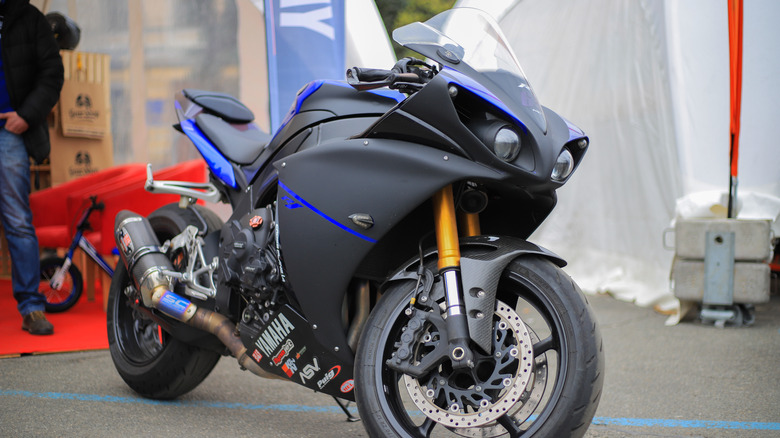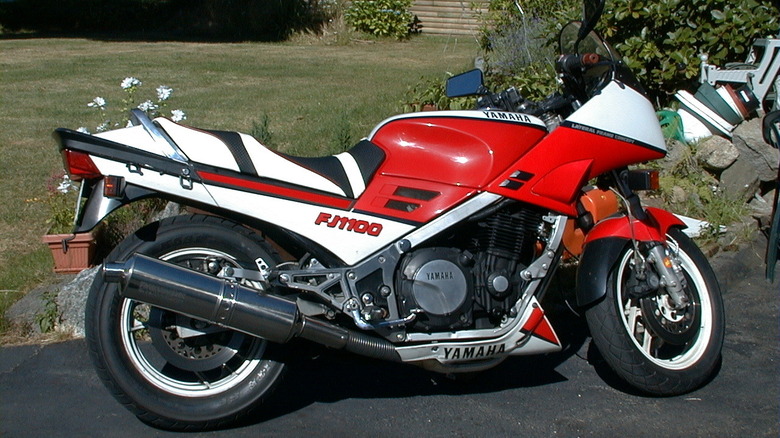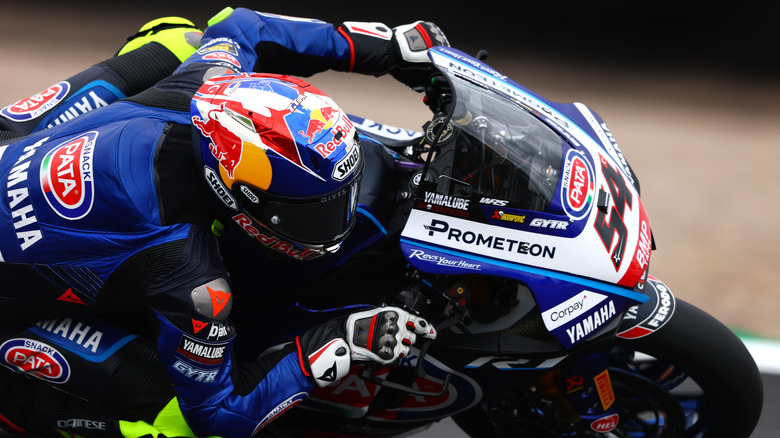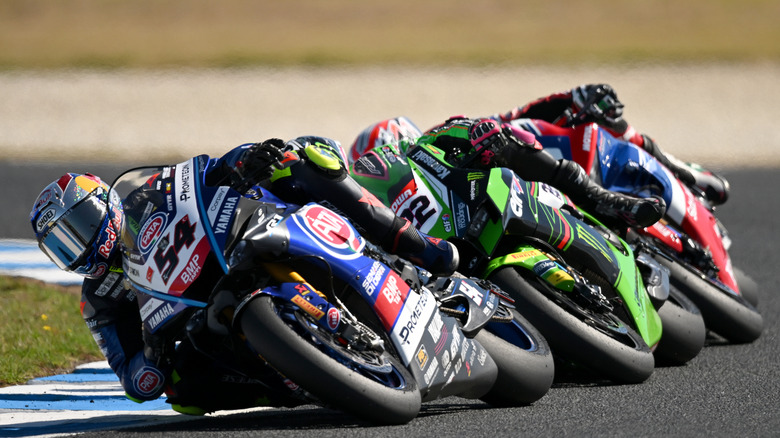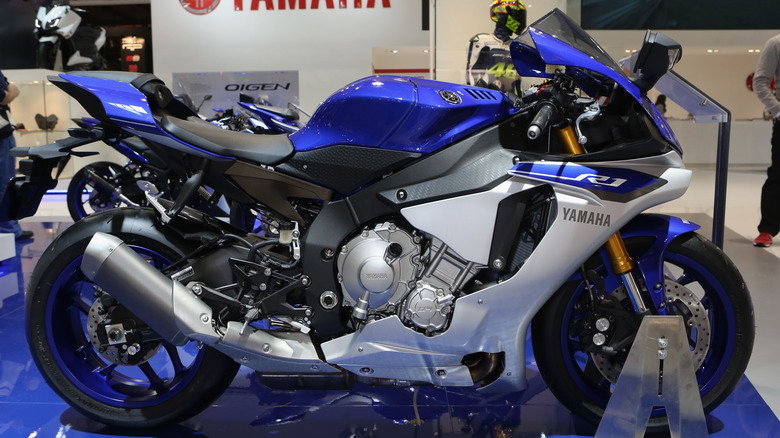Here's How The Yamaha YZF-R1 Took Sports Bikes To The Next Level
You don't need to know the complex differences between a wide variety of types of motorcycles to have a grasp of one key thing: Sports bikes are speed machines. It's a generalization to say that they're strictly for racing only, but you'll certainly see the best of the best sports bikes represented out on high-profile tracks.
There'll often be at least one Yamaha model racing as well. The Japanese brand has a long history with racing bikes, first competing in July 1955's Mt. Fuji Ascent Race — the very same month that Yamaha Motor Co., Ltd was officially created. Of the many sports bikes Yamaha has developed over its long history, one of the most important would be the YZF-R1.
These bikes need something more than just speed. More than performance, or style, as important as these factors are. In addition, it would be easier, and surely safer, to just iterate slightly on an existing model's specs and declare the result the "fastest yet," but the only way to really change the game is to try something new.
The YZF-R1 was an attempt to combine all of these factors, and it was one of the most intriguing sports bikes in the company's (and the industry's) history. Let's take a closer look, starting with the context for its creation. It may not be an ideal ride for beginners, but it's certainly powerful.
Setting the scene for Yamaha's YZF-R1
In 2001's "Performance Motorcycles," Mick Walker states that 1969's Honda CB750 was the first superbike. That model, Walker goes on, "was responsible for a whole new market sector in the motorcycle industry; the age of the multi-cylinder bike with a deluxe specification had arrived." It was a new market, of course, that industry heavyweights such as Yamaha were quick to jump on board with.
In the years that followed, Yamaha set its sights on diversifying its range to appeal to more than just a new breed of superbike enthusiasts. 1970's HT-1, for instance, was a 6.3kW single-cylinder trail model, designed more for modest comfort on a range of terrain than screaming around tracks. Yamaha would then establish something of a blueprint for its superbikes, only to go on to promptly rewrite it with the YZF-R1.
The 1984 FJ1100 could be seen as the piece that defined the direction of Yamaha's sports bikes of the era. It boasted 125 horsepower and a quite astonishing top speed of around 146 mph. At up to 555.5 lbs, too, it wasn't a huge or impractical pain to ride; being rather modest in dimensions and equipped with side-mounted tubes rather than top-mounted, positioned to keep its size and heft low. The model could be summarized as sporting performance belied by its size. What Yamaha then did with the YZF-R1 in the late 1990s was take these virtues and elevate them further.
[Featured image by Dr. Fiero via Wikimedia Commons | Cropped and scaled | Public Domain]
What set the Yamaha YZF-R1 apart?
An innovative vehicle design begins with aesthetics. In the case of sports bikes, style isn't just for show. As unique as the YZF-R1 looked next to its contemporaries, being eye-catching was a distant second priority next to ensuring that the placement of the components worked for the machine (primarily designed for road use, rather than racing).
The concept of what works, however, is a fluid one that's open to interpretation. Some contemporary models, such as Kawasaki's Ninja 1000, were as notable for their bulk (weighing in at 590 pounds) as for the heft of its engines. The Ninja 1000R's 159-mph top speed was a new record for production models in 1986, but it seemed that such speed came with a heavy, boxier bike. What the YZF-R1 did to transform this way of thinking was to further build on what Yamaha had achieved with the FJ1100: To show that speed, power, and a less formidable frame could all be combined in one machine.
The key to this was extending the swingarm and a design style dubbed "three axis." This system is defined by the positioning of the primary shaft and crank, placing the components in close proximity. Yamaha designer Kunihiko Miwa pioneered this new layout for Yamaha, and in doing so, created an new type of sports bike.
The pace and performance of the Yamaha YZF-R1
At 998cc, the original YZF-1000 R1 was a bold venture into its engine category. That engine, in fact, was a DOHC four-cylinder — enabling the model to reach a maximum of 148 horsepower and 172 mph. Packing all of this in its sleek and (relatively) slender body was quite the engineering feat, but another aspect of the YZF-R1 that would elevate it further was its handling.
Motorcycles with powerful engines don't necessarily need to be intimidatingly heavy. By extension, such models don't need to be unwieldy to control either. In the specific case of the YZF-R1, Ken Nemoto quotes Yamaha's Yoshitaka Kojima as explaining, "it's by no means a highly rigid chassis. We had actually tried to create a rather low level of rigidity."
The unique placement of the bike's components comes into play here too, Nemoto explains, as the rigidity of the R1's body was balanced to heighten its performance both in turns and on straight stretches.
The layout is known as Yamaha's Deltabox frame, an adaptation of the diamond frame concept in which the front and back wheel's output is respectively concentrated on the front and back of the frame. This adaptable setup had already been established in Yamaha supersports models for over a decade before the R1's arrival, and several of the R1's qualities would influence the industry afterwards.
The development and legacy of the Yamaha YZF-R1
Honda's successful CBR900RR FireBlade was a prominent model that paved the way for a machine that combined a lightweight frame and mighty engine, and the YZF-R1 was a further advancement of that concept. To remain the influential icon it became, however, it underwent several changes over the years — both subtle and super significant.
The 2002 model boasted 152 horsepower, a Delta Box III design, and fuel injection. By 2007, its output had been further bolstered to 180 horsepower and the Yamaha Chip Controlled Throttle was added to the line. With the latter system, the idea of more efficient and environmentally-friendly operation came into sharper focus, and continued to do so as the new models in the line released. The R1 2020, for instance, featured a further-advanced fuel injection system in efforts to adhere to the then-new Euro5 rules on fuel emissions.
The YZF-R1, all in all, has been a unique and potent machine since its introduction in the late 1990s. Blending bold looks, high performance, efficiency and a suite of features with racing roots, it established itself as a force of nature — and a street-legal one, at that. The notion of a machine that ticks all of these boxes was a blueprint that other motorcycle manufacturers would go on to target. Yamaha continues to be a force in the industry, and the R1 undoubtedly contributed to this in its own way.
